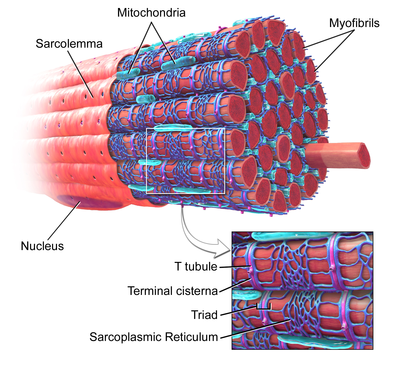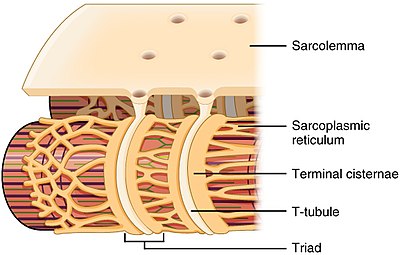Triad (anatomy)
| Triad | |
|---|---|
 Skeletal muscle, showing Triad as well as T-tubule. | |
 Triad and T-tubule structure and relationship to the sarcoplasmic reticulum in skeletal muscle. | |
| Anatomical terminology |
In the histology of skeletal muscle, a triad is the structure formed by a T tubule with a sarcoplasmic reticulum (SR) known as the terminal cisterna on either side.[1] Each skeletal muscle fiber has many thousands of triads, visible in muscle fibers that have been sectioned longitudinally. (This property holds because T tubules run perpendicular to the longitudinal axis of the muscle fiber.) In mammals, triads are typically located at the A-I junction;[1] that is, the junction between the A and I bands of the sarcomere, which is the smallest unit of a muscle fiber.
Triads form the anatomical basis of excitation-contraction coupling, whereby a stimulus excites the muscle and causes it to contract. A stimulus, in the form of positively charged current, is transmitted from the neuromuscular junction down the length of the T tubules, activating dihydropyridine receptors (DHPRs). Their activation causes 1) a negligible influx of calcium and 2) a mechanical interaction with calcium-conducting ryanodine receptors (RyRs) on the adjacent SR membrane. Activation of RyRs causes the release of calcium from the SR, which subsequently initiates a cascade of events leading to muscle contraction. These muscle contractions are caused by calcium's bonding to troponin and unmasking the binding sites covered by the troponin-tropomyosin complex on the actin myofilament and allowing the myosin cross-bridges to connect with the actin.
See also
- Diad, a homologous structure in cardiac muscle
References
- ^ a b di Fiore, Mariano SH; Eroschenko, Victor P (2008). Di Fiore's Atlas of histology: with functional correlations. Philadelphia: Wolters Kluwer Health/Lippincott Williams & Wilkins. p. 124. ISBN 0-7817-7057-2.
